Click on the photo of the Aura hybrid for a huge high-res gallery
When Saturn was first unveiled by then General Motors Chairman Roger Smith in 1985, it was intended to be GM's import-fighting division. They introduced production and sales techniques that were unique to the domestic auto industry. The initial lineup of compact S-Series cars that came to market sold reasonably well for a time and Saturn dealers got high marks from consumers. But it took until 1999 for Saturn to add a second model to the lineup in the form of the mid-sized L-Series which were based on the then current Opel Vectra. Unfortunately the Saturn had blander styling and flabbier handling than its German cousin and never really took off. The L-Series was killed off in 2005 and there was a one year hiatus before a replacement appeared.
The new Aura was introduced in the fall of 2006 and took Saturn in a whole new direction from its original intent. GM's import killer division has effectively become the North American arm of GM Europe. The front half of the Aura and Vectra are basically the same with the main styling difference being the rear half of the greenhouse and the tail. The Vectra sedan has a more formal roofline compared to the Aura's sloping rear glass.
The two cars are also a much closer match in other more important ways that you can read about after the jump.
When Saturn was first unveiled by then General Motors Chairman Roger Smith in 1985, it was intended to be GM's import-fighting division. They introduced production and sales techniques that were unique to the domestic auto industry. The initial lineup of compact S-Series cars that came to market sold reasonably well for a time and Saturn dealers got high marks from consumers. But it took until 1999 for Saturn to add a second model to the lineup in the form of the mid-sized L-Series which were based on the then current Opel Vectra. Unfortunately the Saturn had blander styling and flabbier handling than its German cousin and never really took off. The L-Series was killed off in 2005 and there was a one year hiatus before a replacement appeared.
The new Aura was introduced in the fall of 2006 and took Saturn in a whole new direction from its original intent. GM's import killer division has effectively become the North American arm of GM Europe. The front half of the Aura and Vectra are basically the same with the main styling difference being the rear half of the greenhouse and the tail. The Vectra sedan has a more formal roofline compared to the Aura's sloping rear glass.
The two cars are also a much closer match in other more important ways that you can read about after the jump.
Beginning with the Aura, the Sky roadster and continuing with the recently launched Vue and the upcoming Astra, all future Saturns will be shared with Opel (except for the Outlook full-sized cross-over). One of the biggest complaints about Saturns prior to the Aura were the gaping spaces between body panels that were necessitated by the plastic panels which expanded in hot weather. Thanks to the steel skin that the Aura and future Saturns have, the car has a much higher quality appearance than previous models with tight consistent panel gaps. The body panels and paint were smooth and looked great. The styling is modern, crisp and handsome without any of the awkward gimmicks of the Ion or the first generation Vue. The Aura, like the Chevy Malibu, is built on GM's Epsilon 1 platform and uses the longer 112.3 inch wheelbase from the Malibu Maxx/Opel Signum hatchbacks combined with a sedan body style.

2007 Opel Vectra on the left, the Aura Green Line on the right
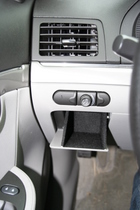 One place where the Opel and Saturn differ is the interior. The layout and look of the interior of the Aura is generally very pleasing to the eye and the touch but there are some annoying details. When you look at the sketches done by interior designers details like the gap between the door panel and the end of the dash is typically no more than a single line drawn in after the fact. If the interior trim wraps from the dashboard into the doors, it's really important to make sure that all those pieces are aligned when you assemble it. When you sit in a car that appears to wrap around you it can look really good unless there is a quarter inch vertical step between the horizontal dash trim and the corresponding pieces on the doors. Two other Auras I looked at had a similar flaw with one actually having one side higher than the dash. The 1990 Lumina rental car I rode in many years ago was far worse but given the quality of the materials in the Aura seeing such an obvious lapse is particularly annoying. Saturn might have been better off keeping the Opel dashboard that doesn't have this issue.
One place where the Opel and Saturn differ is the interior. The layout and look of the interior of the Aura is generally very pleasing to the eye and the touch but there are some annoying details. When you look at the sketches done by interior designers details like the gap between the door panel and the end of the dash is typically no more than a single line drawn in after the fact. If the interior trim wraps from the dashboard into the doors, it's really important to make sure that all those pieces are aligned when you assemble it. When you sit in a car that appears to wrap around you it can look really good unless there is a quarter inch vertical step between the horizontal dash trim and the corresponding pieces on the doors. Two other Auras I looked at had a similar flaw with one actually having one side higher than the dash. The 1990 Lumina rental car I rode in many years ago was far worse but given the quality of the materials in the Aura seeing such an obvious lapse is particularly annoying. Saturn might have been better off keeping the Opel dashboard that doesn't have this issue.

The RHD Vauxhall Vectra dash board on the left, Aura on the right
On the plus side the layout of the Aura interior works well with everything falling readily to hand. There are redundant radio controls along with the cruise control switches on the steering wheel. Although AutoblogGreen's test car didn't have leather the thick steering wheel felt good in the hands. Adjacent to the fuel gauge was the economy gauge which lets the driver know when the hybrid system is providing boost and when it's charging the battery. Keeping the needle in the center of the gauge provides the best economy. One of the best aspects of the interior is the front seats. Unlike both the Altima and Escape hybrids I've driven recently the bottom seat cushion was long enough to provide good thigh support. The front seats also provided excellent lateral support and most importantly were very comfortable. In fact, the Aura seats may well be the best seats I've ever tried in a GM car.
The long wheelbase provides ample room in the back and the scooped out front seat backs enhance that further. Unlike the Altima, which lost its fold down rear seat to the placement of the battery, the Aura seat backs still fold down. The smaller battery still blocks out part of the opening but at least a slot is available to pass thin objects through. The trunk itself is on the small side at only 13.1 cu. ft. but it's well shaped and the cavities behind each wheel well have a cargo net, making them perfect for storing small items without sliding all over the trunk during spirited driving. Under the trunk floor in the space that would normally hold the spare tire is another storage bin and a tire inflater/sealer. Drivers who get a leak and stop before destroying the sidewalls can plug in the inflater which will inject sealer and pump up the tire. If your tire suffers a more catastrophic failure, you're out of luck and you'll have to use the OnStar button on the rear view mirror.
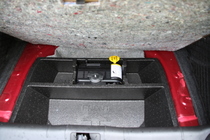
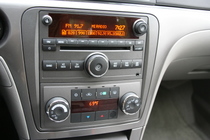
The Aura currently uses the same mild hybrid Belt-Alternator-Starter (BAS) system first introduced on the Vue Green Line last year. The system is designed to give a boost in efficiency with a relatively low cost system. The efficiency improvement is not as big as what could be achieved with a strong hybrid but at a base price of $22,045 it costs $3,000 to $4,000 less than an Altima or Camry hybrid. As a hybrid the Aura makes use of regenerative braking to recapture kinetic energy in the battery that can then be fed back into the powertrain when the driver needs some extra acceleration boost. This allows for the use of a less powerful, more efficient engine that can be boosted by the belt driven alternator-starter system when needed. A big part of the cost savings is in the battery which has limited capacity. The GM BAS system uses a 36V NiMH battery from Cobasys.
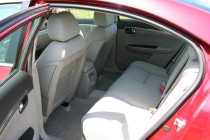 Unlike the hybrid systems from Ford, Toyota and Nissan, the Aura doesn't use an electro-hydraulic brake system and the regenerative braking is not blended with friction braking. This allows for a lower cost brake system and the regenerative braking is controlled entirely from the powertrain controller. Unfortunately the regen control doesn't talk to the brake control system and the regen braking is overlaid on the friction braking. That means that doing a moderate brake apply and then releasing the brake sometimes results in continued deceleration due to the regen until the battery capacity is maxed out or the accelerator is re-applied. The amount of decel is small but noticeable and because it depends on the state of charge of the battery the decel is inconsistent. The friction braking system does work well with good pedal feel and modulation and unlike the Escape hybrid, the Aura does have traction control.
Unlike the hybrid systems from Ford, Toyota and Nissan, the Aura doesn't use an electro-hydraulic brake system and the regenerative braking is not blended with friction braking. This allows for a lower cost brake system and the regenerative braking is controlled entirely from the powertrain controller. Unfortunately the regen control doesn't talk to the brake control system and the regen braking is overlaid on the friction braking. That means that doing a moderate brake apply and then releasing the brake sometimes results in continued deceleration due to the regen until the battery capacity is maxed out or the accelerator is re-applied. The amount of decel is small but noticeable and because it depends on the state of charge of the battery the decel is inconsistent. The friction braking system does work well with good pedal feel and modulation and unlike the Escape hybrid, the Aura does have traction control.
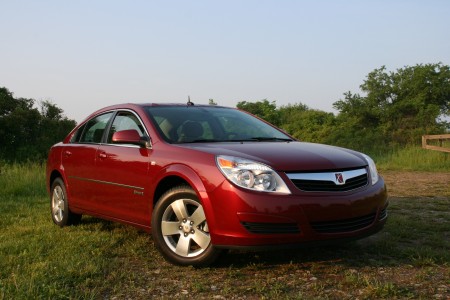
Driving the Aura is generally a very pleasant experience for people who like to drive. The long wheelbase and the chassis tuning provide a supple ride that never ever feels floaty. The combination of spring rates and the damping allow the suspension do its job of absorbing the craters and frost heaves that characterize Michigan roads in a way that is always in control but never punishes the passengers. Cornering is flat with only mild understeer and that thick steering wheel has nice weight even if it only has minimal feedback. The biggest complaint about the driving experience is the four-speed automatic transmission. The mild hybrid system uses a conventional torque converter automatic rather than the continuously variable systems used in other full hybrid systems. While the transmission could certainly use at least one if not two more forward gears, my complaint is with the somewhat harsh upshifts. Downshifts were fine but even moderate acceleration causes a noticeable jerk when the box moves to the next gear. Hopefully a software update for the powertrain controller is forthcoming.
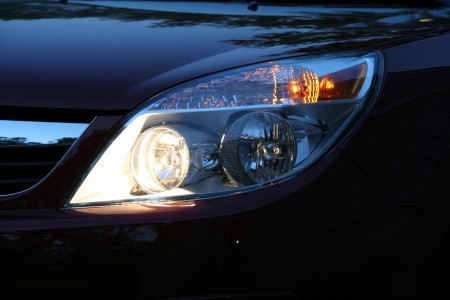
So what does it all mean? The Saturn Aura is generally a fine sedan that's pleasurable to drive. The closest conventional powertrain combination GM offers is in the G6 with the same 2.4L/4spd automatic combination. The new 2008 EPA numbers rate the Aura at 24/32/27mpg (city/hwy/comb) while the G6 is rated at 20/30/24mpg. In 376 miles of my usual mixed driving I managed 25.7mpg. The GM mild hybrid system does buy you a few miles per gallon at a relatively modest price. The sample I drove priced out at $23,070, significantly lower than any comparable hybrid on the market. Of course it can't match the 32mpg of the Altima Hybrid I tested or even the 31mpg of my old 111,000 mile '98 Dodge Stratus. If GM dropped in one of their new six-speed boxes or the new Two-Mode hybrid setup, it would be a killer. As it is, it's an attractively styled, reasonably efficient, family sedan for a reasonable price. The Aura is huge step forward for General Motors and hopefully they can address those few issues before production of the new Malibu starts this fall.
For a second take on the Aura Green Line check out what Alex has to say over on our sister site Autoblog.com and check out more cars from the AutoblogGreen Garage:
- 2008 Ford Escape Hybrid
- 2007 Toyota Highlander Hybrid
- 2007 Nissan Altima Hybrid
- 2007 Volkswagen Passat TDI
- 2007 Saturn Vue Green Line
- Ford Focus FCV
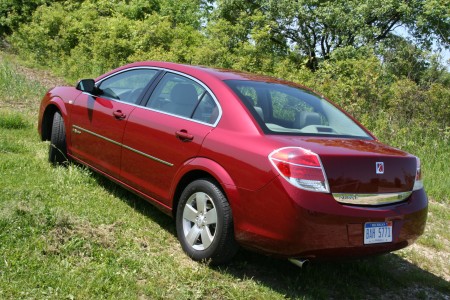
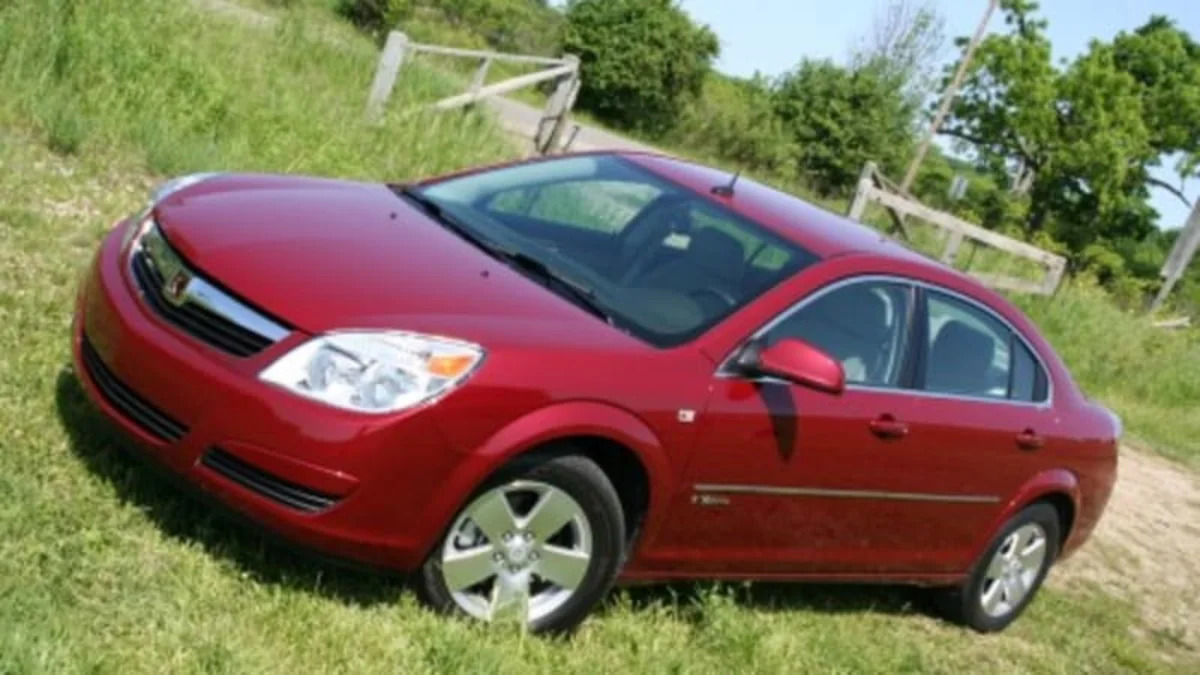

Sign in to post
Please sign in to leave a comment.
Continue